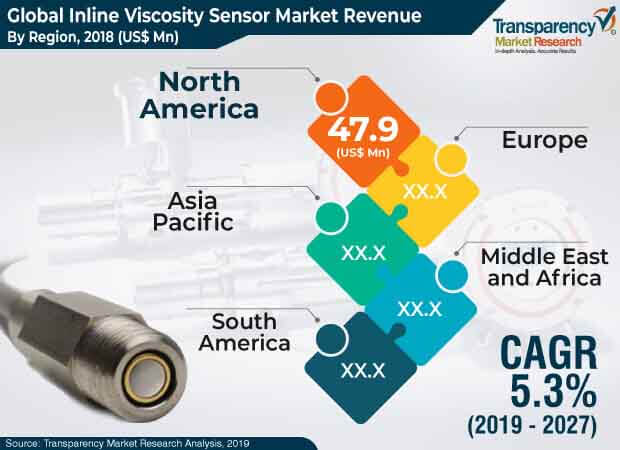Inline Viscosity Sensors Market Worth US$ 243.0 Mn by 2027Posted by surendra choudhary on February 19th, 2020  According to a new research report pertaining to the inline viscosity sensors market, published by Transparency Market Research , the global inline viscosity sensors market is expected to reach value of US$ 243.0 Mn by 2027, expanding at a CAGR of 5.3% from 2019 to 2027. According to the report, the market would continue to be influenced by a range of macroeconomic and market-specific factors. In terms of demand, North America would continue to lead the global market, with the market in the region expanding at a CAGR of 5.6% from 2019 to 2027. China, India, Japan, and South Korea are anticipated to be major contributors to the inline viscosity sensors market in Asia Pacific during the forecast period. Increasing use of viscometers in chemical industry driving the global inline viscosity sensors market In the chemical industry, viscosity measurement of chemical products is required for quality control in production lines. For chemical fluids, obtaining the appropriate viscosity is required so as to deliver desired end-product quality; optimize material use; and maintain smooth running of equipment. For More Details, Request A PDF Sample Report @ https://www.transparencymarketresearch.com/sample/sample.php?flag=S&rep_id=66539 Moreover, in different types of chemical applications such as ink, paint, and glue, viscometers are used to detect changes in color, density, stability, and molecular weight. This factor is driving the global inline viscosity sensors market. In view of advantages offered by viscometers in various applications in the chemical industry, the demand for viscosity sensors is anticipated to increase significantly during the forecast period. Across the globe, manufacturers of inline viscosity sensors are increasing their investments in the inline viscosity sensors market in order to meet the increasing demand from various industry verticals such as oil & gas, chemical, biotechnology, food & beverages, and automotive. Global Inline Viscosity Sensors Market: Scope of Report The global inline viscosity sensors market has been broadly segmented in terms of type, application, and geography. Based on type, the global market has been segmented into sphere, cylinder, and rod. In terms of revenue, the cylinder segment accounted for a major market share of more than 35% in 2018. The segment is anticipated to expand at a CAGR of 5.8% during the forecast period. In order to fulfill the global demand, manufacturers of inline viscosity sensors are focusing on research and development activities on a regular basis in order to invent advanced applications of inline viscosity sensors. Inline viscosity sensors are used in different types of viscosity measurement applications. Capacity expansion by refining industries led by rising energy needs and regulatory norms imposed on emissions in the oil & gas industry are key factors expected to drive the global demand for inline process viscometers. This, in turn, is likely to fuel the demand for inline viscosity sensors during the forecast period. Based on application, the inline viscosity sensors market has been segregated into oil & gas, biotech, automotive, chemical, and food & beverages. In terms of revenue, the chemical segment held the maximum market share in 2018. In addition to this, in terms of both value and volume, the segment is expected to expand at the maximum CAGR during the forecast period. Growing competition in chemical and oil & gas industries has encouraged companies to re-organize their procedure parameters in refining, chemical processing, and blending practices. This, in turn, is estimated to boost the demand for inline viscosity, temperature, and density measurement instruments during the forecast period. This factor is anticipated to boost the adoption for inline viscosity sensors during the forecast period. As per TMR analysis, North America accounted for a leading i.e. more than 30% share of the global inline viscosity sensors market, in terms of both revenue and volume, in 2018. The Asia Pacific inline viscosity sensors market is primarily driven by increased investments in modernizing of infrastructure and risen urban population, especially in developing economies such as China and India. The global inline viscosity sensors market is projected to witness further modifications, innovations, and advancements in inline viscosity sensors in the near future, as several leading manufacturers are investing in research and development activities. Global Inline Viscosity Sensors Market: Competition Dynamics The research study includes profiles of leading companies operating in the global inline viscosity sensors market. Market players have been profiled in terms of attributes such as company overview, financial overview, business strategies, and recent developments. Some of the key players operating in the global market are Ametek Brookfield, PAC L.P., VAF Instruments B.V., Parker Kittiwake, Martechnic GmbH, Cambridge Viscosity Inc.(PAC), A&D, AVENISENSE, Merimex Industries, Hydramotion, Emerson Electric, Sofraser, Rheology Solution, Anton Paar GmbH, Galvanic Applied Sciences, LEMIS Process, and A&D Company. Various business strategies are being adopted by leading players. Companies are focusing on expanding their business by developing strategic partnerships and offering innovative solutions. Like it? Share it!More by this author |


